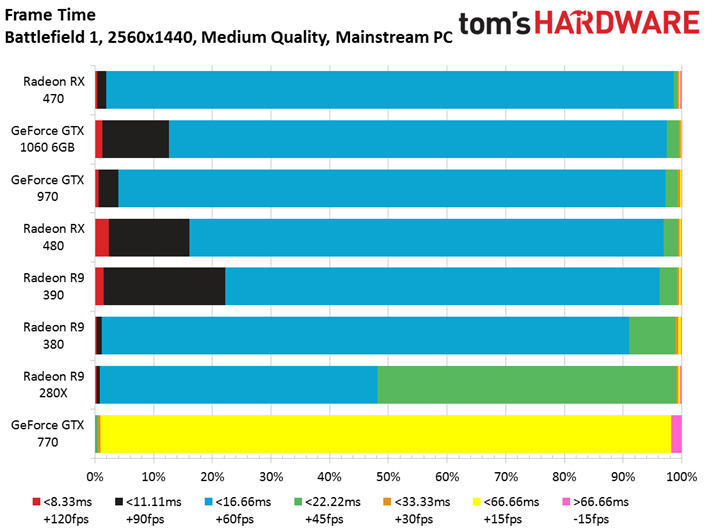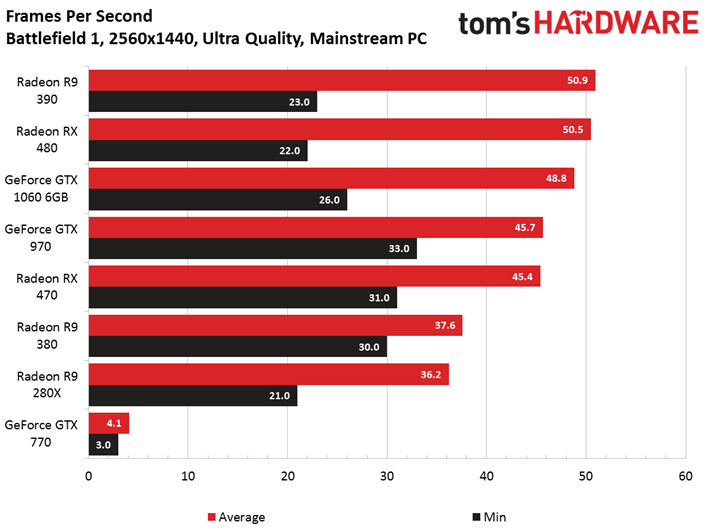Battlefield 1 Performance In DirectX 12: 29 Cards Tested
Mainstream PC, 2560x1440
Based on the previous page’s charts, we already know that far fewer of the graphics cards you’d pair with an old FX cut it at 2560x1440. That allows us to trim our test field to fit in one set of charts per quality preset.
Low Quality Preset





It appears we could have cut even more. Even at Low quality, the 2GB GeForce GTX 770 is overwhelmed by QHD. Everything else fares quite a bit better. The minimums we report are mostly registered at the beginning of the run where performance is consistently lower for each contender.
Compared to 1920x1080, where AMD’s Radeon RX 480 posted better results than Nvidia’s GeForce GTX 1060 6GB, the opposite is true at 2560x1440 (though the difference is imperceptible). Similarly, whereas the RX 470 previously bested Nvidia’s GeForce GTX 970, QHD has both cards switching places.
Medium Quality Preset





Most of these cards maintain playable performance as we step up to the Medium preset; only Nvidia’s GeForce GTX 770 is completely stymied.
High Quality Preset





The Hawaii GPU’s ability to render 64 pixels per clock gives it a quantifiable advantage over Ellesmere’s 32 pixels per clock as we shift from Medium to High details. This allows the Radeon R9 390 to take a first-place finish ahead of the RX 480.
Both Radeons beat Nvidia’s GeForce GTX 1060 though, which led using Low quality, fell one position under Medium, and drops to third in these charts. A narrower aggregate memory bus and less available bandwidth seem to hurt GP106 compared to the R9 390 (384 GB/s) and RX 480 (256 GB/s).
Our frame time over run chart helps illustrate the GTX 770’s plight. It also uncovers occasional spikes from the R9 280X. Perceived smoothness doesn’t appear to be affected, but that’s definitely not a behavior we see from the other contenders.
Get Tom's Hardware's best news and in-depth reviews, straight to your inbox.
Ultra Quality Preset





Every card stumbles through the first few seconds of our benchmark with Ultra settings enabled, so the minimum frame rates aren’t representative of much other than a tumultuous intro. Based on what we've seen so far, this appears related to the 990FX platform's reduced I/O throughput compared to more modern platforms.
More interesting, perhaps, is that the ~$175 Radeon RX 470 ends this run pretty much tied with GeForce GTX 970, a card that debuted at $330 less than three years ago. Both cards are more or less playable with averages in the mid-40s and reasonable frame time distributions.
The question to answer as we move forward will be whether stepping up to a higher-end platform improves the gaming experience on a given card. Let’s set our FX-based machine aside, swap in the Core i7-6700K, and start back in at 1920x1080.
MORE: Best Graphics Cards
MORE: Desktop GPU Performance Hierarchy Table
MORE: All Graphics Content
Current page: Mainstream PC, 2560x1440
Prev Page Mainstream PC, 1920x1080 Next Page High-End PC, 1920x1080-
envy14tpe Wow. The amount of work in putting this together. Thanks, from all the BF1 gamers out there. You knocked my socks off, and are pushing me to upgrade my GPU.Reply -
computerguy72 Nice article. Would have been interesting to see the 1080ti and the Ryzen 1800x mixed in there somewhere. I have a 7700k and a 980ti it would be good info to get some direction on where to take my hardware next. I'm sure other people might find that interesting too.Reply -
Achaios Good job, just remember that these "GPU showdowns" don't tell the whole story b/c cards are running at Stock, and there are GPU's that can get huge overclocks thus performing significantly better.Reply
Case in point: GTX 780TI
The 780TI featured here runs at stock which was 875 MHz Base Clock and 928 MHz Boost Clock, whereas the 3rd party GPU's produced ran at 1150 MHz and boosted up to 1250-1300 MHz. We are talking about 30-35% more performance here for this card which you ain't seeing here at all. -
xizel Great write up, just a shame you didnt use any i5 CPUS, i would of really liked to se how an i5 6600k competes with its 4 cores agains the HT i7sReply -
Verrin Wow, impressive results from AMD here. You can really see that Radeon FineWine™ tech in action.Reply -
And then you run in DX11 mode and it runs faster than DX12 across the board. Thanks for effort you put in this but rather pointless since DX12 has been nothing but pile of crap.Reply
-
NewbieGeek @XIZEL My i5 6600k @4.6ghz and rx 480 get 80-90 fps max settings on all 32 v 32 multiplayer maps with very few spikes either up or down.Reply -
Jupiter-18 Fascinating stuff! Love that you are still including the older models in your benchmarks, makes for great info for a budget gamer like myself! In fact, this may help me determine what goes in my budget build I'm working on right now, which I was going to have dual 290x (preferably 8gb if I can find them), but now might have something else.Reply

